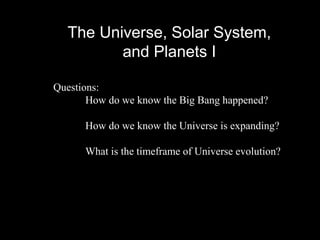
The Universe, the eight planets, The sun
- 1. The Universe, Solar System, and Planets I Questions: How do we know the Big Bang happened? How do we know the Universe is expanding? What is the timeframe of Universe evolution?
- 2. News Flash: NASA/CNN report first stars formed early than once thought
- 3. Edwin Hubble at Mt. Wilson Hubble guiding the Hooker 100 inch telescope in 1923. The Hooker 100 inch telescope atop Mt. Wilson near Pasadena, CA. It was the largest telescope in the world from 1917-1947. Hubble’s observations at the 100 inch during the 1920’s led him to the conclusion that the universe is expanding, and that an object’s recession velocity is proportional to its distance from the observer.
- 4. A deep image of an “empty” portion of the sky with the Hubble Space Telescope reveals that the universe is filled with galaxies- many just like our own. The light we see from the most distant galaxies has traveled approx- imately 10 billion years to reach us. Deep Hubble Space Telescope Image
- 5. Using the Doppler Effect to Measure Velocity Blueshift Redshift
- 6. Calcium Magnesium Sodium Galaxy Spectrum Stellar Spectrum Spectra of a nearby star and a distant galaxy Star is nearby, approximately at rest Galaxy is distant, traveling away from us at 12,000 km/s Galaxy Spectroscopy
- 7. Origin of the Universe - Did It Begin with a Big Bang?
- 8. Penzias and Wilson, 1965 Arecibo Dish, Puerto Rico Discovery of the Background Radiation from initial Big Bang -Long wavelength -came from all directions
- 9. Early History of the Universe • Matter as we know it did not exist at the time of the Big Bang, only pure energy. Within one second, the 4 fundamental forces were separated – gravity - the attraction of one body toward another – electromagnetic force - binds atoms into molecules, can be transmitted by photons – strong nuclear force - binds protons and neutrons together in the nucleus – weak nuclear force - breaks down an atom’s nucleus, producing radioactive decay
- 10. Early History of the Universe • After 3 minutes, photons and neutrons began to fuse to form the nuclei of hydrogen and helium atoms • About 300,000 years later, temperatures were cool enough for complete hydrogen and helium atoms to form • Photons escaped from matter about the same time, and light existed for the first time
- 11. Changing Composition of the Universe • 200 million years later, with expansion still occurring, stars and galaxies began forming from leftover matter - hydrogen and helium – nuclear fusion in stars has reduced the original composition of 100% H and He to 98% – when a dying star explodes, the heavier elements created by fusion are blown into space to be recycled by newly forming stars – the overall composition of the galaxies is gradually changing to the heavier elements
- 12. The Solar System - Its Origin and Early Development Our solar system, part of the Milky Way galaxy, consists of the Sun, nine planets, 64 known moons, many asteroids, millions of comets and meteorites, as well as interplanetary dust and gases
- 13. The Solar System - Its Origin and Early Development
- 14. General Characteristics of the Solar System • Planetary orbits and rotation – planet and satellite orbits are in a common plane – nearly all planet and satellite orbital and spin motions are in the same direction – rotation axes of nearly all planets and satellites are roughly perpendicular to the plane of the ecliptic
- 15. General Characteristics of the Solar System • Chemical and physical properties of the planets – the terrestrial planets are small, have a high density, and are composed of rock and metallic elements – the Jovian planets are large, have a low density, and are composed of gases and frozen compounds • Slow rotation of the Sun • Interplanetary material – existence and location of asteroid belt – distribution of interplanetary dust
- 16. Meteorites - Visitors from Outer Space – Stones - composed of iron and magnesium silicates, about 93% of all meteorites – Irons - composed of iron and nickel alloys – Stony-Irons - nearly equal amounts of iron and nickel and silicate minerals • Meteorites are believed to be pieces of material that originated in the formation of the Solar System about 4.6 billion years ago